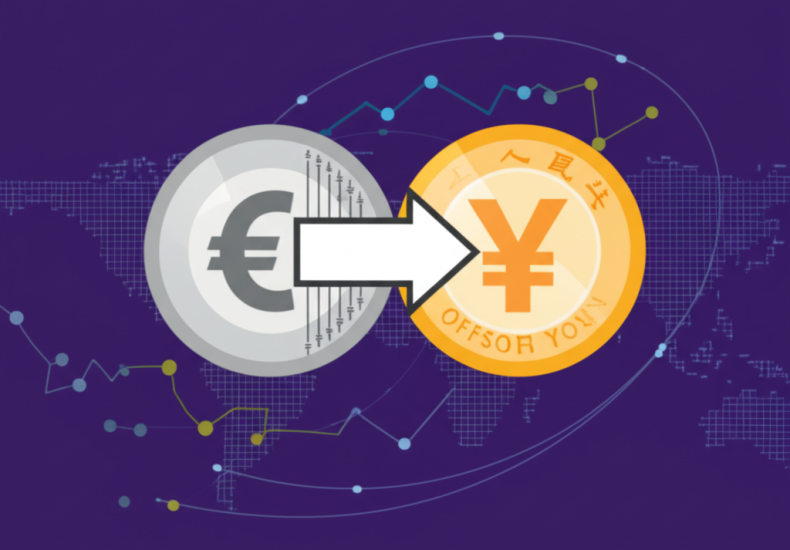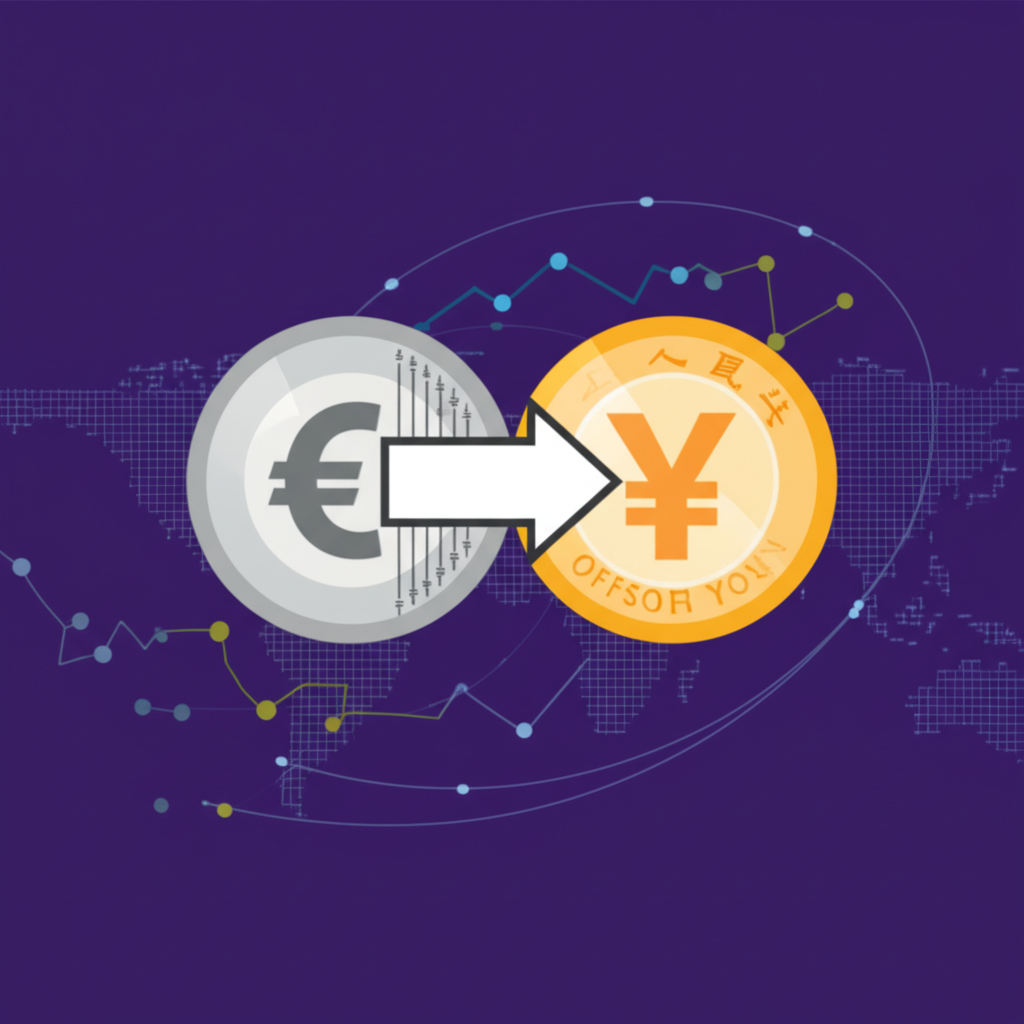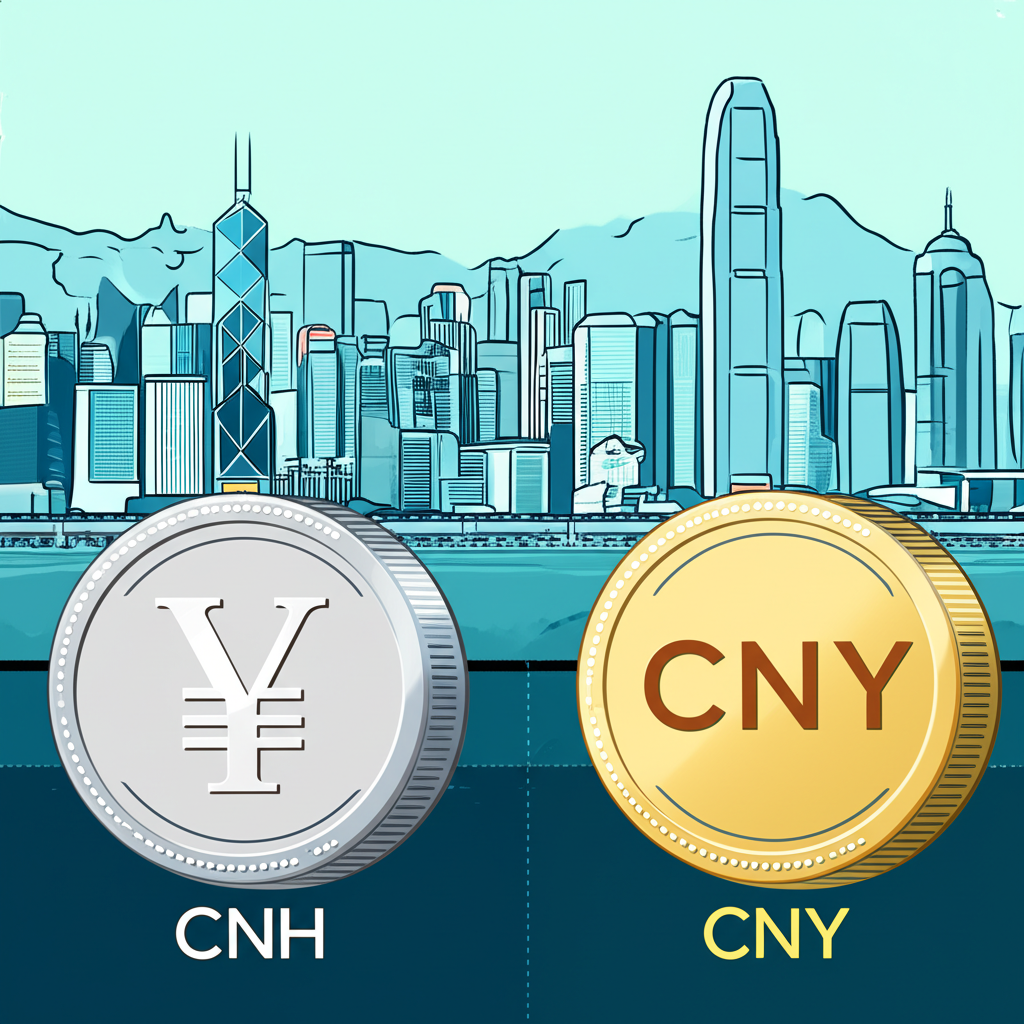
EUR CNH: 7 Key Factors Driving the Euro-Offshore Yuan Exchange Rate?
Table of Contents
ToggleIntroduction to EUR CNH: What is This Key Currency Pair?

The EUR CNH exchange rate tracks the value of the Euro against the offshore Chinese yuan, offering a direct window into the financial relationship between two of the world’s most influential economic regions. Unlike traditional pairs that involve the U.S. dollar, EUR CNH operates as a cross currency, reflecting shifting dynamics between the Eurozone and China without intermediary exposure. As trade, investment, and policy coordination between Europe and China evolve, this pair becomes increasingly relevant for global investors seeking to understand capital flows and macroeconomic trends beyond the dollar-centric framework.
The Euro represents the monetary union of 20 European Union nations, with its value shaped by collective economic performance and decisions made by the European Central Bank. Meanwhile, the offshore yuan—known as CNH—serves as China’s currency in international markets, offering a more flexible and accessible version of the renminbi compared to its tightly regulated onshore counterpart. Movements in EUR CNH are not just about exchange rates; they reflect broader narratives around growth divergence, monetary policy divergence, and geopolitical alignment. For financial professionals, businesses with cross-border operations, and traders focused on emerging market exposure, tracking this pair provides strategic insights into how Europe and China navigate global economic shifts.
Understanding CNH: Offshore vs. Onshore Yuan (CNY)

A critical foundation for understanding EUR CNH lies in recognizing the difference between the offshore yuan (CNH) and the onshore yuan (CNY). Though both represent the same national currency, their operational environments differ significantly, affecting liquidity, pricing, and accessibility for international participants.
The onshore yuan, or CNY, circulates within mainland China under a tightly managed regime. The People’s Bank of China (PBOC) sets a daily reference rate and allows the currency to trade within a narrow band, typically ±2% around that fix. Capital controls restrict the movement of money in and out of the country, limiting foreign access to the domestic financial system. As a result, CNY is primarily used for domestic transactions and is less responsive to global market forces.
In contrast, the offshore yuan (CNH) was developed to support international trade and investment. Traded freely in financial centers such as Hong Kong, London, and Singapore, CNH operates with fewer restrictions and is subject to market-driven supply and demand. While still influenced by PBOC policy signals—especially through its daily CNY fixing and broader macroprudential measures—CNH pricing reflects real-time investor sentiment, speculative flows, and global risk appetite. This makes it a more accurate barometer for how international markets view the yuan’s strength.
| Feature | CNY (Onshore Yuan) | CNH (Offshore Yuan) |
|---|---|---|
| Market Location | Mainland China | Outside mainland China (e.g., Hong Kong, London) |
| Convertibility | Restricted, capital controls apply | More freely convertible, fewer restrictions |
| Pricing | Managed float, tightly controlled by PBOC | More market-driven, influenced by global supply/demand |
| Accessibility | Limited for non-residents | Accessible for international investors and businesses |
| Primary Purpose | Domestic trade and economy | International trade, investment, and reserve currency aspirations |
This structural distinction is not merely technical—it has real implications for traders and institutions. For instance, during periods of capital outflow pressure, CNH may depreciate faster than CNY, signaling market stress before it’s fully reflected onshore. Conversely, strong foreign demand for yuan assets can push CNH higher, encouraging the PBOC to allow gradual appreciation in CNY.
Why CNH Matters for Global Investors

For international investors, the CNH market serves as a vital entry point into China’s vast economy without requiring direct access to restricted domestic financial channels. It enables participation in yuan-denominated bonds, cross-border trade settlements, and portfolio investments, particularly through programs like the Hong Kong-Shanghai Stock Connect or Bond Connect.
Liquidity in the CNH market has grown substantially over the past decade, supported by the establishment of offshore clearing banks and central bank swap lines between the PBOC and major global counterparts. This infrastructure supports smoother execution and tighter spreads, making EUR CNH more viable for active trading and hedging. Multinational corporations engaged in trade with China also use CNH to invoice exports and imports, reducing reliance on the U.S. dollar and lowering transaction costs.
Moreover, the internationalization of the yuan remains a strategic goal for Beijing. In 2016, the IMF included the RMB in the SDR basket, marking a significant milestone in its journey toward reserve currency status. While the yuan still lags behind the dollar and euro in global reserves, increasing use of CNH in bilateral trade agreements—such as those with European partners—signals growing acceptance. For investors, this trend enhances the long-term relevance of EUR CNH as a tool for diversification and exposure to shifting global monetary dynamics.
Live EUR CNH Exchange Rate and Interactive Charts

Accessing the live EUR CNH exchange rate is essential for timely decision-making in fast-moving markets. Real-time pricing allows traders to react to breaking news, economic data releases, and central bank statements as they happen. Given the sensitivity of both the Euro and CNH to policy shifts, even minor deviations from expectations can trigger sharp moves, making up-to-the-minute data indispensable.
Interactive charts enhance this capability by transforming raw numbers into visual narratives. A well-designed EUR CNH chart enables users to analyze price action across multiple timeframes—from one-minute ticks for scalpers to monthly views for long-term investors. These platforms often integrate technical indicators such as moving averages, Relative Strength Index (RSI), MACD, and Bollinger Bands, helping traders identify momentum, overbought or oversold conditions, and potential reversal points.
Many trading interfaces also offer drawing tools, Fibonacci retracements, and volume overlays, which are particularly useful when assessing support and resistance levels. For example, a trader might observe that EUR CNH has repeatedly failed to break above 8.2000, suggesting strong supply at that level. Combined with real-time news feeds and economic calendars, these tools form a comprehensive analytical suite for managing EUR CNH positions effectively.
Platforms provided by major brokers, financial data vendors like Bloomberg or Refinitiv, and independent forex websites offer robust charting solutions. Some even allow algorithmic backtesting and automated trading strategies, catering to both retail and institutional users. As the pair gains traction, especially among Asia-Europe focused funds, the availability and sophistication of these tools continue to improve.
Interpreting EUR CNH Historical Data and Trends
Historical analysis of EUR CNH provides context that real-time data alone cannot offer. By examining long-term charts, investors can identify cyclical patterns, structural shifts, and macroeconomic turning points that shape the pair’s trajectory. For instance, during the European debt crisis of 2011–2012, the Euro weakened broadly, including against CNH, despite China’s own growth slowdown. More recently, divergent monetary policies—such as ECB tightening while the PBOC eased—have driven sustained EUR CNH rallies.
Long-term trends often reflect fundamental imbalances. A persistent current account surplus in China, coupled with strong foreign direct investment inflows, has historically supported CNH appreciation. Meanwhile, structural challenges in the Eurozone—such as demographic pressures or energy dependency—can weigh on the Euro over extended periods. Overlaying these fundamentals with price data helps separate noise from meaningful directional moves.
Shorter-term historical analysis, on the other hand, supports tactical trading. Day traders and swing traders study intraday or weekly charts to detect chart patterns—like head and shoulders, triangles, or double tops—that may precede breakouts or reversals. They also examine how the pair reacted to past events, such as PBOC rate cuts or ECB stimulus announcements, to anticipate future responses.
It’s important to note that while historical patterns can be informative, they do not guarantee future outcomes. Structural changes—such as new capital controls, geopolitical realignments, or financial innovation—can render past behavior obsolete. Therefore, historical analysis should be combined with forward-looking fundamental and technical assessments for optimal results.
Key Factors Influencing EUR CNH Movements
The EUR CNH exchange rate is shaped by a complex web of factors originating from both sides of the economic divide, as well as global forces that indirectly influence investor sentiment.
Eurozone Economic Indicators and ECB Policy
The strength of the Euro hinges largely on the economic health of the Eurozone. Key metrics such as GDP growth, inflation (measured by CPI), unemployment rates, industrial production, and retail sales provide regular updates on the region’s trajectory. Stronger-than-expected data typically boosts confidence in the Euro, while weak readings can trigger risk-off behavior and currency outflows.
However, no single institution wields more influence than the European Central Bank. The ECB’s interest rate decisions, asset purchase programs, and forward guidance directly affect the yield differential between Euro-denominated and other global assets. When the ECB adopts a hawkish stance—raising rates or signaling future hikes—it increases the attractiveness of holding Euros, often leading to appreciation. Conversely, dovish policies such as quantitative easing or rate cuts tend to depress the currency.
Market participants closely monitor ECB press conferences, policy statements, and minutes for subtle shifts in tone. Even a single word change—such as replacing “gradual” with “significant” in describing rate hikes—can move markets. The ECB’s balance sheet size, inflation forecasts, and assessments of growth risks all feed into trader expectations, which are often priced in well ahead of official decisions.
Chinese Economic Performance and PBOC Actions
On the Chinese side, economic data releases such as quarterly GDP, industrial output, fixed asset investment, retail sales, and trade balances play a crucial role in shaping CNH sentiment. As an export-driven economy, China’s trade surplus with Europe and the rest of the world influences demand for its currency. A widening surplus often supports CNH, while a contraction may lead to depreciation pressure.
The People’s Bank of China maintains significant influence over CNH, even though it operates offshore. While the PBOC does not directly set CNH rates, it guides expectations through its daily CNY fixing, adjustments to the Loan Prime Rate (LPR), reserve requirement ratios (RRR), and public statements on exchange rate stability. For example, if the PBOC lowers the LPR to stimulate lending, it may weaken the yuan by reducing yield appeal, affecting both CNY and CNH.
Moreover, the PBOC occasionally intervenes indirectly by adjusting liquidity in offshore markets or issuing guidance to state-owned banks. In May 2024, a Reuters report noted the central bank’s pledge to keep the yuan “basically stable,” a signal aimed at calming markets amid volatility. Such statements carry weight because they reflect the government’s tolerance for currency swings and its willingness to act when necessary.
Global Geopolitical and Trade Relations
Beyond economic data, geopolitical developments exert a powerful influence on EUR CNH. The European Union and China are major trading partners, with billions in goods and services exchanged annually. Disruptions—whether from tariffs, sanctions, supply chain bottlenecks, or diplomatic tensions—can alter trade flows and investor confidence.
For example, EU investigations into Chinese electric vehicle subsidies have sparked debate over potential retaliatory measures. If protectionist policies escalate, European exporters could face reduced access to Chinese markets, weakening demand for EUR. Conversely, Chinese firms seeking European expansion may increase their EUR holdings, supporting the currency.
Broader global dynamics also matter. Since CNH is often traded against the U.S. dollar, movements in USD/CNH can spill over into EUR CNH. If the dollar strengthens due to Fed tightening, CNH may weaken broadly, dragging down its value against the Euro unless the ECB simultaneously tightens policy. Similarly, risk-off events—such as geopolitical conflicts or financial crises—can drive investors toward safe-haven assets, impacting EUR and CNH differently based on perceived stability.
Trading and Investing in EUR CNH
Engaging with the EUR CNH market requires a solid grasp of forex mechanics and an awareness of the unique characteristics that differentiate it from more conventional pairs.
Understanding Spreads, Leverage, and Margin
Successful trading begins with understanding core concepts:
– **Spreads**: The difference between the bid and ask price represents the transaction cost. EUR CNH typically has wider spreads than major pairs like EUR/USD due to lower liquidity, especially during Asian off-hours. Traders should compare spreads across brokers to minimize costs.
– **Leverage**: Allows control of large positions with minimal capital. While 1:50 or 1:100 leverage is common, it magnifies both gains and losses. A small adverse move can lead to significant losses if not managed properly.
– **Margin**: The collateral required to maintain leveraged positions. If the market moves against a position and equity falls below maintenance margin, a margin call occurs, potentially resulting in automatic liquidation.
These tools offer opportunity but demand discipline. Many traders underestimate how quickly losses can accumulate when leverage is misused. Practicing with demo accounts and starting with small position sizes can help build experience before committing real capital.
Comparing EUR CNH with Other Major Pairs (e.g., USD/CNH, EUR/USD)
To better understand EUR CNH, it’s helpful to view it in relation to other key currency pairs:
– **USD/CNH**: As the most liquid yuan pair, USD/CNH often sets the tone for broader yuan sentiment. A rising USD/CNH indicates yuan weakness, which may extend to EUR CNH unless the Euro strengthens independently. Traders often watch USD/CNH for early signals of PBOC tolerance for depreciation.
– **EUR/USD**: Reflects the relative strength of the Euro against the dollar. If EUR/USD is rising while USD/CNH is stable or falling, EUR CNH is likely to appreciate. This triangular relationship allows traders to isolate EUR and CNH strength separately.
Analyzing correlations between these pairs can reveal divergences that signal trading opportunities. For example, if EUR/USD is flat but EUR CNH is rising, it suggests CNH-specific weakness, possibly due to capital outflows or PBOC easing. Such insights support more nuanced decision-making than analyzing EUR CNH in isolation.
Advanced Strategies and Risk Management for EUR CNH
Given its exposure to two major economies with differing policy frameworks, EUR CNH demands a strategic and disciplined approach.
Technical vs. Fundamental Analysis for EUR CNH
A blended analytical approach yields the best results:
– **Fundamental Analysis** focuses on macro drivers: interest rate differentials, growth outlooks, trade balances, and policy direction. Traders using this method monitor economic calendars, central bank speeches, and government reports to assess long-term trends.
– **Technical Analysis** examines price behavior, identifying patterns, trendlines, and momentum indicators. It helps determine optimal entry and exit points, especially in trending or range-bound markets.
The most effective traders combine both. For example, if the ECB signals rate hikes and China reports weak industrial output, the fundamental case for EUR CNH strength strengthens. A concurrent breakout above a key resistance level on the chart could confirm the move, providing a high-probability entry signal.
Other tools, such as sentiment analysis (using positioning data from CFTC or broker flows) and intermarket analysis (monitoring bond yields, equity markets, and commodity prices), add further depth. For instance, rising German bund yields relative to Chinese government bonds may foreshadow EUR CNH strength.
Managing Volatility and Geopolitical Risks
EUR CNH can experience sudden and sharp movements, particularly around key data releases or geopolitical events. Effective risk management is non-negotiable:
– **Position Sizing**: Limit exposure to a small percentage of total capital—typically 1% to 2% per trade—to withstand adverse moves.
– **Stop-Loss Orders**: Automatically close losing trades at predefined levels, preventing emotional decisions during volatility.
– **Take-Profit Orders**: Lock in gains at target levels, ensuring profits aren’t erased by reversals.
– **Diversification**: Avoid overconcentration in a single currency pair. Spread risk across different asset classes or currency exposures.
– **Stay Informed**: Subscribe to real-time news alerts, especially on EU-China relations, trade policy, and central bank communications.
– **Hedging**: Corporations with EUR or CNH exposure can use forwards, options, or currency swaps to hedge transaction risk. Given CNH’s unique regulatory environment, choosing the right execution venue—such as Hong Kong-based banks—is crucial for efficient hedging.
The Future Outlook for EUR CNH
Looking ahead, the trajectory of EUR CNH will hinge on several interlocking variables. On the Eurozone side, the pace of economic recovery—particularly in core economies like Germany and France—will shape ECB policy. Persistent inflation could lead to extended tightening, supporting the Euro. However, political fragmentation or energy insecurity could undermine confidence and limit policy flexibility.
In China, the PBOC faces the dual challenge of stimulating growth while maintaining financial stability. Efforts to boost domestic consumption, expand green finance, and deepen capital market reforms could enhance CNH appeal. However, structural headwinds—including property sector risks and demographic decline—pose challenges. Any significant slowdown in exports or renewed trade friction could pressure the yuan.
Geopolitically, the evolving EU-China relationship will remain a key driver. While economic interdependence persists, strategic competition over technology, supply chains, and standards introduces friction. Investment screening mechanisms, anti-subsidy investigations, and diplomatic tensions may create headwinds for bilateral cooperation, impacting investor sentiment.
Additionally, the broader trajectory of USD/CNH will continue to influence EUR CNH. As the dollar remains the dominant global reserve currency, its strength or weakness creates ripple effects across all yuan crosses. A weakening dollar could support CNH broadly, while dollar strength may force defensive measures from the PBOC.
Despite these uncertainties, the long-term trend points toward greater integration of the yuan into global finance. As China promotes cross-border usage through digital yuan pilots, bilateral swap agreements, and inclusion in more global indices, CNH’s role is set to expand. This evolution ensures that EUR CNH will remain a strategically important pair for investors navigating the balance between advanced and emerging market dynamics.
Conclusion
The EUR CNH currency pair stands at the intersection of two major economic powers, offering a nuanced reflection of their evolving relationship. More than just an exchange rate, it encapsulates the interplay of monetary policy, trade dynamics, and geopolitical currents between Europe and China. Understanding the distinction between offshore (CNH) and onshore (CNY) yuan is essential, as it reveals how international markets access and price exposure to China’s economy.
Driven by a mix of Eurozone fundamentals, ECB policy, Chinese growth data, PBOC guidance, and global risk sentiment, EUR CNH presents both opportunity and complexity. Traders must navigate its volatility with a combination of technical precision, fundamental insight, and disciplined risk management. Tools like live charts, economic calendars, and intermarket analysis enhance decision-making, while awareness of geopolitical developments ensures preparedness for unexpected shifts.
As both regions adapt to new economic realities—from energy transitions to digital currencies—the importance of EUR CNH is likely to grow. For investors seeking diversified exposure, hedging strategies, or insight into East-West financial flows, this pair offers a compelling lens into the future of global finance. Its continued relevance underscores the need for informed, agile, and forward-looking engagement in today’s interconnected markets.
1. What is the difference between CNH and CNY?
CNH (Offshore Chinese Yuan) is traded outside mainland China, primarily in financial hubs like Hong Kong, and is more freely convertible and market-driven. CNY (Onshore Chinese Yuan) is traded within mainland China, is subject to stricter capital controls, and its exchange rate is more tightly managed by the People’s Bank of China (PBOC).
2. What factors primarily influence the EUR CNH exchange rate?
The EUR CNH exchange rate is influenced by Eurozone economic indicators (e.g., GDP, inflation, interest rates), ECB monetary policy, China’s economic performance (e.g., GDP growth, trade balance), PBOC actions, and global geopolitical and trade relations between the EU and China, as well as with other major powers.
3. Is EUR CNH a good currency pair for beginners to trade?
While offering significant opportunities, EUR CNH can be quite volatile and influenced by complex economic and political factors. Beginners should approach it with caution, gaining a solid understanding of forex fundamentals, risk management, and the specific drivers of this pair before engaging in significant trading.
4. How can I track the live EUR CNH exchange rate and charts?
You can track live EUR CNH exchange rates and interactive charts through reputable financial news websites, forex brokers’ platforms, and specialized financial data providers. These platforms typically offer real-time quotes, customizable charts, and various technical analysis tools.
5. What are the main risks associated with trading EUR CNH?
The main risks include:
- **Volatility:** Sharp price swings due to economic data or geopolitical events.
- **Geopolitical Risk:** EU-China relations, trade disputes, and global political tensions can significantly impact the pair.
- **Liquidity Risk:** While generally liquid, liquidity can occasionally thin out during specific market conditions.
- **Leverage Risk:** High leverage can magnify losses as well as gains.
- **Regulatory Risk:** Changes in monetary or capital control policies by the ECB or PBOC.
6. How does the PBOC’s policy affect the CNH?
The PBOC (People’s Bank of China) influences the CNH through various policy tools, including interest rate decisions, reserve requirement ratios, and its daily fixing of the CNY. Although the CNH is offshore and more market-driven, the PBOC’s broader stance on currency stability and capital flows significantly impacts sentiment and price action in the CNH market.
7. Can I convert EUR to CNH directly, and where?
Yes, you can typically convert EUR to CNH directly through international banks, specialized currency exchange services, and online forex brokers. Major financial centers with active offshore yuan markets, such as Hong Kong and London, are key locations for such conversions.
8. Why is EUR CNH important for global trade?
EUR CNH is important because it reflects the economic and trade relationship between the Eurozone and China, two of the world’s largest trading blocs. It facilitates cross-border transactions, investment flows, and hedging for businesses engaged in trade between Europe and China, supporting the internationalization of the yuan.
9. What is the general forecast for EUR CNH in the near term?
General forecasts for EUR CNH in the near term depend heavily on the prevailing economic conditions in the Eurozone and China, central bank policies (ECB and PBOC), and global geopolitical developments. Traders should consult expert analyses from reputable financial institutions and keep abreast of real-time news to inform their short-term outlook, as forecasts are subject to rapid change.
10. How does EUR CNH compare to EUR USD in terms of volatility?
EUR CNH can sometimes exhibit higher volatility than EUR USD, especially during periods of significant economic policy announcements from China or major geopolitical events impacting EU-China relations. While EUR USD is highly liquid, EUR CNH’s volatility can be influenced by the less predictable nature of China’s economic data and regulatory environment, though both pairs are susceptible to global market sentiment.
You may also like
Calendar
| 一 | 二 | 三 | 四 | 五 | 六 | 日 |
|---|---|---|---|---|---|---|
| 1 | 2 | 3 | 4 | 5 | 6 | 7 |
| 8 | 9 | 10 | 11 | 12 | 13 | 14 |
| 15 | 16 | 17 | 18 | 19 | 20 | 21 |
| 22 | 23 | 24 | 25 | 26 | 27 | 28 |
| 29 | 30 | 31 | ||||
發佈留言
很抱歉,必須登入網站才能發佈留言。